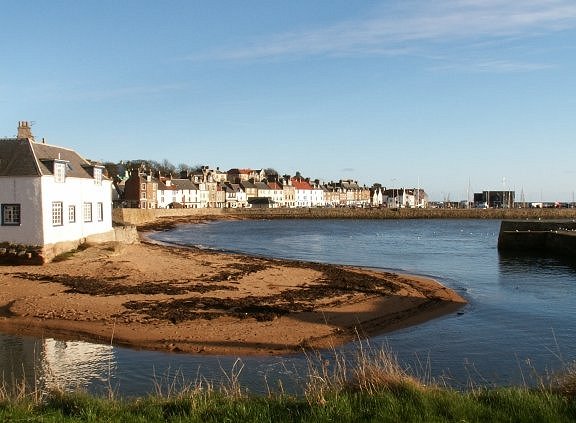|
List Of Golf Courses Designed By Old Tom Morris
Old Tom Morris (16 June 1821 – 24 May 1908) designed or remodelled about 75 golf courses throughout his life in the British Isles, including The Open Championship courses of Prestwick, the Old Course at St Andrews, Muirfield, Royal Portrush, and Carnoustie. GolfPass has said that "You could make an argument that Old Tom Morris is the greatest golf course architect who ever lived". Career Morris started designing golf courses whilst working at Carnoustie, when he was employed as an apprentice to Allan Robertson. Many of the courses that he subsequently designed have since been remodelled, but not all of them. In 1850, Allan Robertson initially designed the Carnoustie Golf Links, Old Tom Morris remodelled and extended it to a full 18 holes in the early 1870s. Carnoustie's only surviving Morris hole is the par 5 6th hole, previously known as "Long", it was officially renamed on 24 September 2003 as "Hogan’s Alley" by the 1999 Open Championship winner at Carnoustie Paul ... [...More Info...] [...Related Items...] OR: [Wikipedia] [Google] [Baidu] |
Old Course At St Andrews
The Old Course at St Andrews, also known as the Old Lady or the Grand Old Lady, is considered the oldest golf course. It is a public course over common land in St Andrews, Fife, Scotland and is held in trust by the St Andrews Links Trust under an act of Parliament. The Royal and Ancient Golf Club of St Andrews clubhouse sits adjacent to the first tee, although it is but one of many clubs (St Andrews Golf Club, The New Golf Club, St Regulus Ladies Golf Club and The St Rule Club are the others with clubhouses) that have playing privileges on the course, along with some other non-clubhouse owning clubs and the general public. Originally known as the "golfing grounds" of St Andrews, it was not until the New Course was opened in 1895 that it became known as the Old Course. History The Old Course at St Andrews is considered by many to be the "home of golf" because the sport was first played on the Links at St Andrews in the early 15th century. Golf was becoming increasingly popular i ... [...More Info...] [...Related Items...] OR: [Wikipedia] [Google] [Baidu] |
St Andrews Ladies’ Putting Club
St Andrews Ladies’ Putting Club, originally known as the St Andrews Ladies Golf Club when it was first established in 1867 for female golf players to use, now the club is also known as the Ladies’ Putting Club of St Andrews, or simply the Putting Club. The club is still a ladies only golf club based in St Andrews, Fife, Scotland. It is generally known to visitors as The Himalayas putting course, which is where the club's members and visitors play, and is thought to be the first minigolf course ever made. The Himalayas name comes about from the peaks and troughs on the course. It has both 9 and 18-hole courses, and is open to men, women and children (6 years of age and above) visitors alike for a nominal fee. The club is the world’s oldest ladies’ golf club. History Before 1860, there were few recreational activities that young women could participate in, apart from croquet, battledore and shuttlecock, and archery. At that time, the caddies of St Andrews laid out a s ... [...More Info...] [...Related Items...] OR: [Wikipedia] [Google] [Baidu] |
Willie Fernie (golfer)
William Fernie (7 May 1855 – 24 June 1924) was a Scottish professional golfer and golf course architect from St Andrews. He won the 1883 Open Championship at Musselburgh Links. The tournament was scheduled to last four rounds of the nine-hole course on a Friday in November. Fernie tied with defending champion Bob Ferguson, with both men shooting 158. The following day Fernie won a playoff by a single stroke. Early life Fernie was born in St Andrews, Scotland, on 7 May 1855. Golf career Fernie was runner-up in the Open Championship in 1882, 1884, 1890 and 1891. When George Strath left Royal Troon in 1887, Fernie took over as club professional and served for 37 years only retiring in January 1924, a few months before his death. As a golf course designer he made alterations to the Old Course at St Andrews and Royal Troon, and designed Turnberry's Ailsa, Felixstowe Ferry Golf Club and Isle of Arran courses. He also designed Appleby Golf Club in 1903, and Dumfries and County G ... [...More Info...] [...Related Items...] OR: [Wikipedia] [Google] [Baidu] |
Elliot, Angus
Elliot is a coastal hamlet in the county of Angus, Scotland, on the westernmost edge of Arbroath on the A92 road. The Elliot Water reaches the North Sea at Elliot. In 1906 Elliot Junction station (now demolished) was the site of a major railway accident in which 22 passengers were killed. The hamlet is served by the X7 Coastrider The X7 Coastrider is an hourly bus route between Perth and Aberdeen via Dundee operated by Stagecoach East Scotland. The service runs seven days per week. History The route was introduced on 12 September 2011 and was initially operated by a fl ... bus. References Villages in Angus, Scotland {{Angus-geo-stub ... [...More Info...] [...Related Items...] OR: [Wikipedia] [Google] [Baidu] |
Anstruther
Anstruther ( sco, Ainster or Enster ; gd, Ànsruthair) is a small coastal resort town in Fife, Scotland, situated on the north-shore of the Firth of Forth and south-southeast of St Andrews. The town comprises two settlements, Anstruther Easter and Anstruther Wester, which are divided by a stream, the Dreel Burn. With a population of 3,500, it is the largest community on the Firth of Forth's north-shore coastline known as the East Neuk. To the east, it merges with the village of Cellardyke. Description Founded as a fishing village, Anstruther is home to the Scottish Fisheries Museum. Recreational vessels are now moored in the harbour, and a golf course is situated near the town. Anstruther Pleasure Cruises operate sightseeing/wildlife cruises from the harbour to the Isle of May, the UK's primary puffin location, on board the vessel the ''May Princess'' from April to October. An abundance of other wildlife, including seal colonies, also inhabit the island. The Waid Academy ... [...More Info...] [...Related Items...] OR: [Wikipedia] [Google] [Baidu] |
James Braid (golfer)
James Braid (6 February 1870 – 27 November 1950) was a Scottish professional golfer and a member of the Great Triumvirate of the sport alongside Harry Vardon and John Henry Taylor. He won The Open Championship five times. He also was a renowned golf course architect. Braid is a member of the World Golf Hall of Fame. Braid was born in Earlsferry, Fife, Scotland, the son of James and Mary (née Harris). He played golf from an early age, working as a clubmaker before turning professional in 1896. Initially his game was hindered by problems with his putting, but he overcame this after switching to an aluminium putter in 1900. He won The Open Championship in 1901, 1905, 1906, 1908 and 1910. In addition, Braid won four British PGA Matchplay Championships (1903, 1905, 1907 and 1911), as well as the 1910 French Open title. He was also runner-up in The Open Championship in 1897, 1902, 1904, and 1909. His 1906 victory in The Open Championship was the last successful defence of the titl ... [...More Info...] [...Related Items...] OR: [Wikipedia] [Google] [Baidu] |
Alyth
Alyth () ( gd, Ailt) is a town in Perth and Kinross, Scotland, northeast of Blairgowrie and about northwest of Dundee. In 2016 the town had an estimated population of 2,400. First mentioned by name in a 12th-century royal charter of William the Lion, Alyth for many centuries was an important market town and entrepôt on long-established drove roads by which Highland farmers brought their sheep and cattle to lowland markets. Another royal charter in 1488, from James III of Scotland granted Alyth the status of Burgh of Barony entitled to stage markets and fairs. The 17th-century stone Packhorse Bridge still stands in the middle of the town (now pedestrian-only), later joined by two other stone bridges for wheeled traffic, emphasising the settlement’s importance as a river-crossing. Agricultural improvements and expanding markets for livestock in the south contributed to Alyth’s prosperity during the 18th and early 19th centuries, while water-power provided by the Alyth ... [...More Info...] [...Related Items...] OR: [Wikipedia] [Google] [Baidu] |
Open Championship
The Open Championship, often referred to as The Open or the British Open, is the oldest golf tournament in the world, and one of the most prestigious. Founded in 1860, it was originally held annually at Prestwick Golf Club in Scotland. Later the venue rotated between a select group of coastal links golf courses in the United Kingdom. It is organised by the R&A. The Open is one of the four men's major golf tournaments, the others being the Masters Tournament, the PGA Championship and the U.S. Open. Since the PGA Championship moved to May in 2019, the Open has been chronologically the fourth and final major tournament of the year. It is held in mid-July. It is called The Open because it is in theory "open" to all, i.e. professional and amateur golfers. In practice, the current event is a professional tournament in which a small number of the world's leading amateurs also play, by invitation or qualification. The success of the tournament has led to many other open golf tourna ... [...More Info...] [...Related Items...] OR: [Wikipedia] [Google] [Baidu] |
Hazard (golf)
A hazard is an area of a golf course in the sport of golf which provides a difficult obstacle, which may be of two types: (1) water hazards such as lakes and rivers; and (2) man-made hazards such as bunkers. The governing body for the game of golf outside the US and Canada, The R&A, say that ''A "hazard" is any bunker or water hazard''. Special rules apply to play balls that fall in a hazard. For example, a player may not touch the ground with their club before playing a ball, not even for a practice swing. A ball in any hazard may be played as it lies without penalty. If it cannot be played from the hazard, the ball may be hit from another location, generally with a penalty of one stroke. The Rules of Golf govern exactly from where the ball may be played outside a hazard. Bunkers (or sand traps) are shallow pits filled with sand and generally incorporating a raised lip or barrier, from which the ball is more difficult to play than from grass. Bunker A bunker is a depression n ... [...More Info...] [...Related Items...] OR: [Wikipedia] [Google] [Baidu] |
Irrigation
Irrigation (also referred to as watering) is the practice of applying controlled amounts of water to land to help grow Crop, crops, Landscape plant, landscape plants, and Lawn, lawns. Irrigation has been a key aspect of agriculture for over 5,000 years and has been developed by many cultures around the world. Irrigation helps to grow crops, maintain landscapes, and revegetation, revegetate disturbed soils in dry areas and during times of below-average rainfall. In addition to these uses, irrigation is also employed to protect crops from frost, suppress weed growth in grain fields, and prevent soil consolidation. It is also used to cool livestock, reduce dust, dispose of sewage, and support mining operations. Drainage, which involves the removal of surface and sub-surface water from a given location, is often studied in conjunction with irrigation. There are several methods of irrigation that differ in how water is supplied to plants. Surface irrigation, also known as gravity irri ... [...More Info...] [...Related Items...] OR: [Wikipedia] [Google] [Baidu] |
Drainage
Drainage is the natural or artificial removal of a surface's water and sub-surface water from an area with excess of water. The internal drainage of most agricultural soils is good enough to prevent severe waterlogging (anaerobic conditions that harm root growth), but many soils need artificial drainage to improve production or to manage water supplies. History Early history The Indus Valley civilization had sewerage and drainage systems. All houses in the major cities of Harappa and Mohenjo-daro had access to water and drainage facilities. Waste water was directed to covered gravity sewers, which lined the major streets. 18th and 19th century The invention of hollow-pipe drainage is credited to Sir Hugh Dalrymple, who died in 1753. Current practices Geotextiles New storm water drainage systems incorporate geotextile filters that retain and prevent fine grains of soil from passing into and clogging the drain. Geotextiles are synthetic textile fabrics specially ... [...More Info...] [...Related Items...] OR: [Wikipedia] [Google] [Baidu] |
Lawn Mower
A lawn mower (also known as a mower, grass cutter or lawnmower) is a device utilizing one or more revolving blades (or a reel) to cut a grass surface to an even height. The height of the cut grass may be fixed by the design of the mower, but generally is adjustable by the operator, typically by a single master lever, or by a lever or nut and bolt on each of the machine's wheels. The blades may be powered by manual force, with wheels mechanically connected to the cutting blades so that when the mower is pushed forward, the blades spin or the machine may have a battery-powered or plug-in electric motor. The most common self-contained power source for lawn mowers is a small (typically one cylinder) internal combustion engine. Smaller mowers often lack any form of propulsion, requiring human power to move over a surface; "walk-behind" mowers are self-propelled, requiring a human only to walk behind and guide them. Larger lawn mowers are usually either self-propelled "walk-behind" ... [...More Info...] [...Related Items...] OR: [Wikipedia] [Google] [Baidu] |

_(1).jpg)







